Headlines
 Systems that cool qubits are difficult to scale up in size, posing a challenge for long-distance quantum communication systems. To bypass this issue, JILA Fellows Cindy Regal, Konrad Lehnert and their teams have created a transducer that uses side-banded cooling to convert microwave photons to optical photons.
Systems that cool qubits are difficult to scale up in size, posing a challenge for long-distance quantum communication systems. To bypass this issue, JILA Fellows Cindy Regal, Konrad Lehnert and their teams have created a transducer that uses side-banded cooling to convert microwave photons to optical photons. Quantum technology promises sophisticated cybersecurity solutions that could shake up the future of computing. Companies are setting up shop in Colorado to develop quantum-security measures, with CU Boulder and federal research facilities partnering to boost the state's nascent quantum industry.
Quantum technology promises sophisticated cybersecurity solutions that could shake up the future of computing. Companies are setting up shop in Colorado to develop quantum-security measures, with CU Boulder and federal research facilities partnering to boost the state's nascent quantum industry. Qubits are a basic building block for quantum computers, but they’re also notoriously fragile—tricky to observe without erasing their information in the process. Now, new research from CU Boulder and NIST may be a leap forward for handling qubits with a light touch.
Qubits are a basic building block for quantum computers, but they’re also notoriously fragile—tricky to observe without erasing their information in the process. Now, new research from CU Boulder and NIST may be a leap forward for handling qubits with a light touch.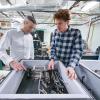 “This is a technology that was developed for something completely different—for creating better atomic clocks and other tools for quantum research,” said Greg Rieker, an associate professor of mechanical engineering at CU Boulder. “Now, we’re making an impact on climate change.”
“This is a technology that was developed for something completely different—for creating better atomic clocks and other tools for quantum research,” said Greg Rieker, an associate professor of mechanical engineering at CU Boulder. “Now, we’re making an impact on climate change.”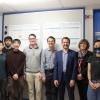 At the invitation of JILA and NIST Fellow Eric Cornell, who has been a scientist at the institute since the 1990s, CU President Todd Saliman toured several laboratories at JILA last month. Saliman was impressed by the research team and Fellows. “You are all working to change the world,” he said.
At the invitation of JILA and NIST Fellow Eric Cornell, who has been a scientist at the institute since the 1990s, CU President Todd Saliman toured several laboratories at JILA last month. Saliman was impressed by the research team and Fellows. “You are all working to change the world,” he said. In a new paper published in Physical Review X, JILA Fellow Adam Kaufman and his team have demonstrated that a specific isotope, mytterbium-171 (171Yb), can store quantum information in stable nuclear qubits—which allows for the ability to quickly manipulate the qubits and produce them in large, uniformly filled arrays.
In a new paper published in Physical Review X, JILA Fellow Adam Kaufman and his team have demonstrated that a specific isotope, mytterbium-171 (171Yb), can store quantum information in stable nuclear qubits—which allows for the ability to quickly manipulate the qubits and produce them in large, uniformly filled arrays.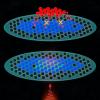 In a joint study, Jun Ye's and Ana Maria Rey's research groups established an experimental setting where they successfully observed Pauli blocking of spontaneous emission by direct measurements of an atom's excited state population. The results have been published in the journal Physical Review Letters.
In a joint study, Jun Ye's and Ana Maria Rey's research groups established an experimental setting where they successfully observed Pauli blocking of spontaneous emission by direct measurements of an atom's excited state population. The results have been published in the journal Physical Review Letters. As World Quantum Day was celebrated by the scientific community, JILA honored their scientists and teams—around 75% of whom study quantum phenomena—and the discoveries that have helped make JILA a world leader in the field. The institute looks forward to what quantum may hold for our future.
As World Quantum Day was celebrated by the scientific community, JILA honored their scientists and teams—around 75% of whom study quantum phenomena—and the discoveries that have helped make JILA a world leader in the field. The institute looks forward to what quantum may hold for our future.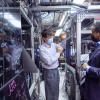 To recognize World Quantum Day on April 14, organized by scientists around the world to raise awareness of the field, CU Boulder Today talked with three graduate students about what the future holds for quantum physics and how quantum discoveries have already fueled the modern, digital age.
To recognize World Quantum Day on April 14, organized by scientists around the world to raise awareness of the field, CU Boulder Today talked with three graduate students about what the future holds for quantum physics and how quantum discoveries have already fueled the modern, digital age.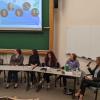 The panel, titled "Women in Quantum: What Does It Take," featured researchers, engineers and physicists from ColdQuanta, Maybell Quantum, Quantinuum and Vescent. Together, they discussed the state of the industry and showcased the rich quantum ecosystem within Colorado.
The panel, titled "Women in Quantum: What Does It Take," featured researchers, engineers and physicists from ColdQuanta, Maybell Quantum, Quantinuum and Vescent. Together, they discussed the state of the industry and showcased the rich quantum ecosystem within Colorado.

